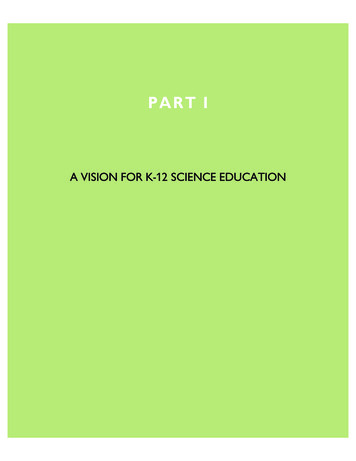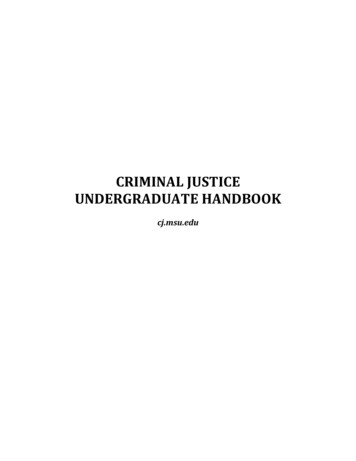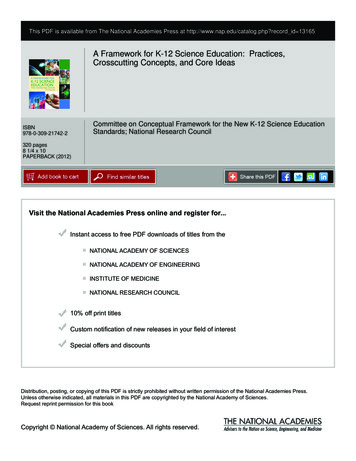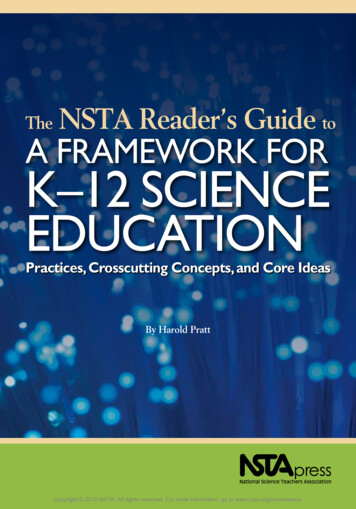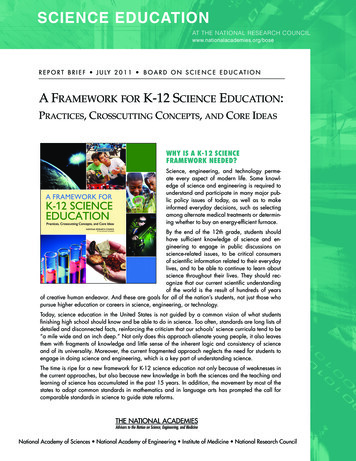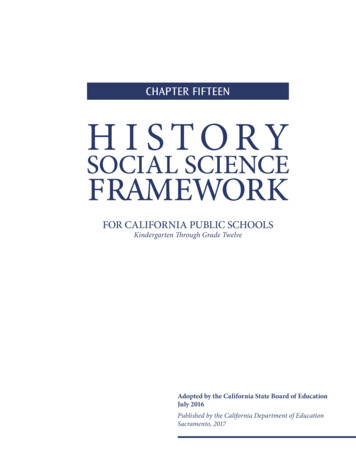
Transcription
CHAPTER FIFTEENH I STORYSOCIAL SCIENCEFRAMEWORKFOR CALIFORNIA PUBLIC SCHOOLSKindergarten Through Grade TwelveAdopted by the California State Board of EducationJuly 2016Published by the California Department of EducationSacramento, 2017
Grade TenCHAPTER 15World History,Culture, andGeography: TheModern WorldnHow did ideas associated with theEnlightenment, the Scientific Revolution,the Age of Reason, and a variety ofdemocratic revolutions develop and impactcivil society?nWhy did imperial powers seek to expandtheir empires? How did colonies respond?What were the legacies of these conquests?nWhy was the modern period definedby global conflict and cooperation,economic growth and collapse, and globalindependence and connection?California History–Social Science Framework Chapter 15317
Grade TenThe tenth-grade course covers a period of more than 250 years and highlightsthe intensification of a truly global history as people, products, diseases,knowledge, and ideas spread around the world as never before. The course beginswith a turning point: the important transition in European systems of governancefrom divine monarchy to a modern definition of a nation-state organized aroundprinciples of the Enlightenment. The course ends with the present, providingample opportunities for teachers to make connections to the globalized world inwhich students live.As students move through the years 1750 through the present, they considerhow a modern system of communication and exchange drew peoples of the worldinto an increasingly complex network of relationships in which Europe and theUnited States exerted great military and economic power. They explore howpeople, goods, ideas, and capital traveled throughout and between Asia, Africa, theAmericas, and Europe. They analyze the results of these exchanges. The ability tosee connections between events and larger social, economic, and political trendsmay be developed by having students consider the most fundamental changes ofthe era:nnThe intensification of the movement toward a global market aided by rapidtransportation of goods around the world, powerful international financialinstitutions, and instantaneous communicationnnThe emergence of industrial production as the dominant economic forcethat shaped the world economy and created a related culture ofconsumptionnnIncreasing human impact on the natural and physical environment throughthe growth in world population, especially urban settings where populationsengaged in mass consumption through mechanical and chemical developments related to the Industrial RevolutionnnImperial expansion across the globe and the growth of nation-states as themost common form of political organizationnnThe application of industrial technology and scientific advancements to thedevelopment of mechanized warfare, which drew millions of people into theexperience of “total war”318Chapter 15 California History–Social Science Framework
Grade TennnThe conflict between economic and political systems that defined the post–World War II periodnnThe emergence of ideas of universal rights and popular sovereignty for allindividuals, regardless of gender, class, religion, or race, which spreadaround the worldThe content covered in grade ten is expansive, and the discipline-specific skillsto be taught are equally demanding. In order to highlight significant developments,trends, and events, teachers should use guiding questions around which theircurriculum may be organized. Organizing content around questions of historicalsignificance allows students to develop their understanding of that content ingreater depth. The questions also allow teachers the leeway to prioritize the contentand highlight particular skills through students’ investigations of the past.Moreover, through an in-depth study of individual events and people, studentscan trace the development of even larger themes, such as the quest for liberty andjustice, the influence and redefinition of national identity, and the rights andresponsibilities of individual citizens. The following questions can frame the yearlong content for tenth grade: How did ideas associated with the Enlightenment,the Scientific Revolution, the Age of Reason, and a variety of democraticrevolutions develop and impact civil society? Why did imperial powers seek toexpand their empires? How did colonies respond? What were the legacies ofthese conquests? Why was the modern period defined by global conflict andcooperation, economic growth and collapse, and global independence andconnection?As students learn about modern world history, they should be encouraged todevelop reading, writing, speaking, and listening skills that will enhance theirunderstanding of the content. As in earlier grades, students should be taught thathistory is an investigative discipline, one that is continually reshaped based onprimary-source research and on new perspectives that can be uncovered. Studentsshould be encouraged to read multiple primary and secondary sources; tounderstand multiple perspectives; to learn about how some things change overtime and others tend not to; and to appreciate that each historical era has its owncontext. It is up to the student of history to make sense of the past on these termsand by asking questions about it.California History–Social Science Framework Chapter 15319
Grade TenThe World in 1750nnHow were most societies organized in the 1700s?nnWho held power in the 1700s? Why?nnWhat was the divine right of kings?Students begin tenth-grade world history with a survey of the world in 1750.This question can frame students’ initial explorations: How were most societiesorganized in the 1700s? Students analyze maps of the gunpowder empires (QingChina, Mughal India, Ottoman Empire, Safavid Persia, Spain, France, England),trade routes (Atlantic World, Pacific/Indian Ocean, and world trade systems), andcolonies.The teacher explains that in 1750, people were living at the very end of thepremodern world. Although there had been many differences in people’sexperiences depending on their location, culture, and language, certain broadpatterns were present in most states and empires.Most states and empires were ruled by one leader, called a king, tsar, sultan,emperor, shah, or prince. Students may consider comparative questions: Who heldpower in the 1700s? Why? This ruler was usually, but not always, a man whocame from a dynasty, a family of rulers. Dynasties changed all the time, whenkings were defeated and overthrown, but the winners would then set up a newdynasty under one leader. The tsar or sultan got his legitimacy from his birth intothe royal family and the support of religious and political elites. Most emperorsclaimed that they had been chosen or blessed by divine power and that they ruledon behalf of God to keep order and justice in the society. The question What wasthe divine right of kings? helps students consider the construction of monarchicgovernments and societies.Besides the royal family, there were elite groups in that society who hadpolitical, military, or religious power, and owned wealth and land. These elitegroups went by different names in each state or empire, such as nobles andscholar–officials, but they had privileges—that is, special rights that ordinarypeople did not have. Elite status was often based on birth. There were not manyelites, either, as they constituted about 3 to 5 percent of the population.320Chapter 15 California History–Social Science Framework
Grade TenBelow the elite groups, there was a small middle class. But the majority of peoplein the world worked as farmers and had little wealth or material possessions, noeducation, and no political power. The reason that this poor farmers group was solarge was because energy, power sources, and technology were limited in thepremodern world. Ninety percent of the people had to work full time at farming,spinning thread for cloth, and doing other repetitive manual jobs to produce food,clothing, and shelter for everyone. The only power sources were human, animal,wind, and water. There was enough surplus in the society only for a smallpercentage of people to have more than basic food, clothing, and shelter.Dynasties and elite groups defended their power, wealth, and privilege throughcustoms of social order, force, and propaganda. They usually resisted giving powerto lower social groups for fear that the nobles or other elites would lose their wealthand privileges. In all societies, customs of social order were hierarchical, meaningthat people were unequal. Some people were higher and considered better thanordinary people.Grade Ten Classroom Example: The Divine MonarchMs. Lee’s tenth-grade class is learning about the divine monarch by focusingon one key speech that King James I delivered in 1610 to Parliament. Ms. Leehas provided an excerpt of this speech (she found it by searching online forKing James I’s “Speech to Parliament” and locates the portion that begins withthe phrase “The state of Monarchy is the supremest thing upon earth . . .” andcontinues for the next three paragraphs) because it illustrates the way in whichkings were perceived to be divinely inspired, and thus their power was understood to be godlike. She has also selected this speech because it clearly lays outthe central claim and supporting details of why King James I felt this way.Ms. Lee begins her lesson by telling students that they will investigate thequestion How did King James I argue that kings are like gods? After providing brief background information about when and how James came to power,Ms. Lee presents the primary source to students. She tells them that this is arelatively straightforward primary source because King James I makes a claim,supports his claims with reasons, and offers evidence for his reasons and centralclaim (in much the same way her students would make a claim in an essay).California History–Social Science Framework Chapter 15321
Grade TenExample (continued)She directs her students to read through the speech a couple of times,making annotations as they find different claims King James I makes. As theyread the speech the first time, they read for the broad claims. As they read it asecond time, Ms. Lee tells students to work on filling in the graphic organizershe has created.The graphic contains boxes in which students are directed to complete thefollowing information: (1) the central claim made by King James I; (2) thereasons for his central claim; (3) the evidence he provides to illustrate hisreasons; (4) the flaw in his reasons.After students complete the graphic, she facilitates table discussions, thenwhole-class discussions, to confirm that the students understand the way inwhich King James I constructs his argument and that the central flaw lies inhis central claim. Ms. Lee then asks them to work in pairs to construct aparagraph response to this central question: How did King James I argue thatkings are like gods?CA CCSS for ELA/Literacy: RH.9–10.1, 2, 5, 8, WHST.9–10.2, 7, 9CA ELD Standards: ELD.PI.9–10.6b, 7, 8, 11a; ELD.PII.9–10.11750–1917: Revolutions Reshape the WorldDemocratic RevolutionsnnHow were enlightened ideas a break from the past?nnHow did the “social contract” affect ordinary people?nnWhat are individual or natural rights? Who received those rights in theeighteenth century?nnWhy did civic reformers argue for representative governments?nnWhat were the consequences of trying to implement political revolutionaryideas in Europe, Latin America, and North America?nnHow do the French, American, and Haitian Revolutions compare to oneanother?322Chapter 15 California History–Social Science Framework
Grade TennnHow is national identity constructed?The eighteenth century witnessed the development of two revolutionary trendsthat ultimately influenced the world in ways that are still felt today: political andindustrial revolutions. Before students learn about the on-the-ground experiencesand consequences of these two revolutions, they should learn about the ideas thatgave rise to them.Revolutionary political ideals were rooted in notions of Athenian democracy,English constitutional laws, the Enlightenment, and other traditions of Europeanpolitical thought, and they emphasize the rule of law, reason, individual rights,republicanism, and citizenship. These concepts are abstract, and the primarysources that illustrate these concepts are dense and challenging for students tonavigate.When possible, teachers should try to introduce brief excerpts of primarysources or secondary sources that convey meaning in a direct way. Even thoughprinciples of political revolutions are challenging to navigate, students should learnthe ideas that guided much of modern history before learning about the reality andput them into a comparative context.The eighteenth-century revolutionary ideas, which influenced much of the worldin the modern period, had its origins in Judeo–Christian culture and Greco–Roman philosophy. Both Jewish and Christian scriptures informed ethical beliefs,while Greek philosophers like Plato and Aristotle were concerned with theestablishment of the rule of law to prevent tyranny. Roman legal philosophy builton Greek ideas of citizenship—defined as the exercise of one’s talents in the serviceof the civic community—was necessary to protect the authority of the state.However, authoritarian ideas, such as divine right of kings, the privileged status ofnobles and clergy, and rule by elite groups were also traditional concepts drawingon ancient ideas and practices.In the 1700s, authoritarian institutions and ideas governed every state andempire, and to Europeans in that time, the revolutionary ideas were quite new. Thisquestion can frame students’ understanding of revolutionary political ideas: Howwere enlightened ideas a break from the past? For students to understand thesignificance of concepts such as the rule of law, citizenship, reason, liberty, andproperty, for example, teachers should present them as a dramatic break from theCalifornia History–Social Science Framework Chapter 15323
Grade Tenpast. As students have just finished learning about the seemingly divine power ofmonarchs, they can begin to see how the new ways of learning and thinking weresubstantially different. Thus, there is a key tension for teachers: emphasizing what abig break from the past these ideas are, but reminding students that the ideas arerooted in ancient societies. The ideas of equality, representation, and rights were soinspiring to people because they emerged in a world dominated by hierarchy,inequality, and lack of representation and rights.Revolutionary political ideas were advocated by civic reformers. Some of themost noted civic reformers were John Locke, Thomas Hobbes, Jean-JacquesRousseau, Charles-Louis Montesquieu, and Adam Smith. These men and otherEnlightenment thinkers developed the notion of the social contract. Studentscan consider this question as they investigate the abstract ideas of politicalrevolutionaries: How did the “social contract” affect ordinary people? The socialcontract was an idea stating that members of a society should agree to cooperatefor mutual social benefits in pursuit of an ordered society.One key component of the social contract that students should learn about isthat men have natural rights to life, liberty, and property. Although some of thesenatural rights were not entirely new, they used to apply only to certain privilegedclasses; civic reformers, however, advocated the idea that all citizens have rightssuch as equality before the law.Students can investigate the questions What are individual or natural rights?Who received those rights in the eighteenth century? as they trace revolutionarypolitical ideas. In addition, they compare the language employed by leadingrevolutionary writers: John Locke (whose Two Treatises of Government will helpstudents understand the connection between the Enlightenment and revolutions),Thomas Jefferson (whose words from the American Declaration of Independencewill prove useful), James Madison (whose Virginia Plan at the ConstitutionalConvention will be useful in teaching students about distribution of power), MaryWollstonecraft (whose A Vindication of the Rights of Woman will providepowerful arguments about women’s rights), and Adam Smith (whose Wealth ofNations provided the foundation for a market economy and the rights orindividuals in that economy).Chapter 15 California History–Social Science Framework
Grade TenStudents can compare the principles that each writer contributed to thesecrucial philosophical and political developments. Once students have beenintroduced to these principles and understand how dramatically different theywere from most Europeans’ recent past, teachers may have students creativelyexplain their understanding of the social contract. Students can create politicalcartoons, perform an original skit, or write a short fictional story to illustrate themain components of the contract.Students also learn that the social contract, especially the notion of naturalrights, gave rise to newer ideas about the purpose of government. This questioncan frame students’ understanding about the relationship between natural rightsand government: Why did civic reformers argue for representative governments?Civic reformers argued that the people should be the basis of government and thatmen create governments to protect natural rights. They argued that these rightswere inherent in human beings and that it was through the social contract thatindividuals ceded certain of their inherent rights to the government in return forcommon benefits such as security, economic regulation, accomplishment ofcommon purposes, and so on. Civic reformers’ concern for personal liberty andsuspicions about the dangers of tyranny led them to argue for a separation ofpowers and embrace representative governments of limited power as the ideal formof political organization.As a foreshadowing of the consequences of these ideas, an extension of this newpurpose of government is the notion that if this new republican form ofgovernment does not protect individuals’ natural rights, then the people have aright to overthrow that government and create a new one in its place.Grade Ten Classroom Example: Connecting Ancient Philosophieswith Revolutionary Political PrinciplesMs. Davis’ tenth-grade class is in the middle of its political revolution unit.Using the free lesson, “Tyranny and the Rule of Law,” from the CaliforniaHistory–Social Science Project, she asks her students to consider the unitquestion: How did tyranny and the rule of law influence revolutionaries?She has provided her students with several primary sources, includingwritings from Rousseau as well as excerpts from Plato’s The Republic andCalifornia History–Social Science Framework Chapter 15325
Grade TenExample (continued)Aristotle’s Politics. She wants students to understand how ancient philosophersimpacted political revolutionary principles in the 1700s, so she presents themwith this secondary source. She directs them to read the directions closely andmake annotations in the text accordingly.Consistent with the directions, Ms. Davis also directs students to read asecondary source, Ancient Philosophers and the American Revolution, whichprovides an overview of the impact of the writing of ancient philosophers onthe political revolutionaries. Specifically, it outlines some of the criticisms thatpolitical revolutionaries among the American colonists had against the Britishmonarch (king or queen) and how the ideas of writers such as Plato andAristotle resonated with American leaders such as Thomas Jefferson.Ms. Davis directs students to put a check mark in the left-hand marginwhen they identify an explanation of the criticism of monarchs and tyranny,and to put an X in the right-hand margin when they see an explanation of therule of law. In their groups, students are then asked to discuss where theyplaced check marks and X’s and explain how these sections help define tyrannyand the rule of law. After students share with their tablemates, Ms. Davisdirects them to review their choices again; making changes as necessary.At the end of this activity, Ms. Davis asks students to work in groups anddevelop brief presentations for the class that address the original question Howdid tyranny and the rule of law influence revolutionaries? Students makeclaims rooted in the various texts they have read.Source: Excerpted from “Tyranny and the Rule of Law,” Curriculum to SupportCalifornia’s Implementation of the Common Core and English LanguageDevelopment Standards. California History–Social Science Project. Copyright 2014, Regents of the University of California, Davis Campus. For more information or to download the free curriculum: wb0qt7gk5eqg.CA HSS Content Standards: 10.1.2. 10.2.1CA HSS Analysis Skills (9-12): Historical Research, Evidence, and Point of View 4; HistoricalInterpretation 1CA CCSS for ELA/Literacy: RH.9–10.1, 5, 6, 8, SL.9–10.1, 4CA ELD Standards: ELD.P1.9–10.1, 6a, 7, 8, 9, 11a; ELD.PII.9–10.1326Chapter 15 California History –Social Science Framework
Grade TenWith an understanding of revolutionary political ideas, students can begin tolearn about the realities that developed from them. What were the consequencesof trying to implement revolutionary political ideas in Europe, Latin America,and North America? Political revolutions erupted in North America, Europe, andLatin America in the eighteenth century. Leaders of all of the revolutions espousedliberal, democratic, and constitutional ideologies. In most cases, these leaders werefrom the bourgeoisie, or middle-class; this group was distinct because it was notfrom the nobility, it tended to hold little power, and it was educated.Although the aims of these revolutions were realized only partially, the ideasspread throughout the world, inspiring reforms and revolutions across the globe.During this period, aristocratic and mercantilist elites continually challenged thepower of monarchs. These conflicts intensified as states increased taxes in an effortto pay the costs of centralizing government administration and rising militaryexpenditures. The Glorious Revolution—when the English Parliament emergedvictorious and the authority of the monarch was limited by the rule of law—was anearly example of this type of contest.In contrast, the American, French, Haitian, and Latin American revolutions acentury later overthrew monarchic authority altogether. In North America,colonists issued the Declaration of Independence, asserting that all men have“unalienable Rights” that they sought to be upheld through a republican form ofgovernment. The French Revolution led to the dissolution of the French monarchy,the establishment of a republic, and universal male participation in politics.Although the French Revolution opened up opportunities for women and slaves topetition for rights, it succumbed first to a destructive Terror, then ultimately todespotism and continental war under Napoleon.American, European, and Latin American revolutionaries defended theiractions using these ideas. Their postrevolutionary constitutions were explicitlywritten to limit executive power and protect the rights of citizens. Students shouldexplore the arguments for individual rights in this era, as well as the exclusion ofgroups such as women from full access to these rights. In particular, they mayconsider the paradox between slavery and individual rights through anexamination of Enlightenment writings and images, including evidence fromabolitionist campaigns and defenses of enslavement.California History–Social Science Framework Chapter 15327
Grade TenA transatlantic republic of letters helped spread revolutionary thinking andactivism. The American and French Revolutions served as models of republicangovernment, which inspired former slaves in Haiti, colonial peoples in LatinAmerica, and military and religious elites in Spain and Portugal to participate inrevolutionary uprisings.Students can make meaning about these revolutions in a comparative context byaddressing the following question: How do the French, American, and HaitianRevolutions compare to one another? Many new leaders established constitutionalgovernments that echoed principles from the Glorious Revolution, Enlightenmentideas embodied in the English Bill of Rights, the French Declaration of the Rights ofMan and the Citizen, and the United States Constitution.Liberal democratic principles, suchas individual rights and the rule of law,replaced traditional aristocraticprivileges. Students may consider howthe universal ideas of theEnlightenment texts provided apolitical tool for disfranchised groupsto press for greater rights in liberaldemocracies during the modern era.Yet these revolutionary principles wereapplied differently in each context. In the Americas, citizenship and natural rightsdid not apply to slaves, women, and many men who did not own property; whilein Haiti, revolutionary principles translated directly to the abolition of slavery.Atlantic revolutions and the subsequent Napoleonic Wars resulted in the establishment of a new type of political structure: the nation-state. Through the growthof popular print media, the centralization of the state, and the increasing connections facilitated by transportation networks, people began to imagine themselvesas part of a larger national community. Students can consider the question How isnational identity constructed? in order to learn about these developments. Thisquestion serves as a bridge to the next unit on industrial revolutions.Shared language, religion, literacy, and culture created connections betweenpeople that served as a foundation for the development of a national identity.328Chapter 15 California History–Social Science Framework
Grade TenArguments over the definition of citizenship, who was included and excluded, inthe nation-state continue into the contemporary period and therefore provideopportunities for students to develop further their own understanding of the rightsand responsibilities of citizens.Industrial RevolutionsnnShould this era of industrialization be called an Industrial Revolution? Whyor why not?nnWhat were the results of the industrial revolutions? How was technology,and the environment transformed by industrialization?nnHow did industrial revolutions affect governments, countries, and nationalidentity in similar and different ways?The Industrial Revolution shifted the center of the world economy from Asia toWestern Europe in the nineteenth century. Students learn that its path divergedsharply from that of China and India, which together had accounted for nearlyhalf of the world’s manufacturing prior to the rise of industrialization. Somehistorians have criticized the use of the term revolution, as the changes brought byindustrialization were often gradual and uneven. Students can wrestle with thistopic by addressing these questions: Should this era of industrialization be calledan Industrial Revolution? Why or why not? From a broad global perspective,however, industrialization has arguably been one of the most dramatictransformations in human history, making available vast stores of undergroundcoal, oil, and gas energy and altering patterns of work, settlement, internationalrelations, consumption, family relations, and values.The Industrial Revolution was energized by coal and eventually by petroleumand natural gas. Fossil fuels that drive steam and electrical engines made possible ahuge increase in the amount of productive energy available to humans. As studentswill learn later in the course, this revolution facilitated the development ofEuropean imperialism in the late nineteenth century. Together, mechanized heavyindustry, a culture of mass consumption, and a global division of labor continue toshape economic growth in the contemporary world, though this growth continuesto be lopsided in its benefits to the world’s population.California History–Social Science Framework Chapter 15329
Grade TenIn addition to its historical significance, the Industrial Revolution also providesrich opportunities for students to develop geographic and economic literacy.Students can consider What were the results of industrialization? in order tocome away with a broad overview of how many aspects of life were transformed byindustrialization. Britain was the first nation to industrialize, benefiting frommany strengths.Students use a variety of maps to explore Britain’s resources, such as navigablerivers and large coal deposits, an available pool of labor, and economic and politicalsystems that encouraged innovation. Students review economic data to see howindustrialization generated profits for Great Britain through its role in worldwidetrade and from goods produced in its colonies. The inventions and discoveries ofJames Watt, Eli Whitney, Henry Bessemer, Louis Pasteur, Thomas Edison, andothers resulted in advances in science and technology. Agricultural and scientificimprovements made possible a more urban and healthy population. Advances inmedicine led to an increasingly institutionalized and professionalized medicalestablishment, which led to an increasing understanding of early germ theory.These new technologies and ways of understanding the world soon spreadbeyond Western Europe to the United States and Japan, so that knowledge wasshared worldwide. Students can also identify the environmental impact of theIndustrial Revolution and discuss the positive and negative consequences ofindustrialization. Students learn that the industrializing nations—for example,Great Britain—were confronted with a wide array of changes from the IndustrialRevolution. The rapidly growing population was putting great demands on thenatural resources
California History–Social Science Framework. Grade Ten. The World in 1750. nn. How were most societies organized in the 1700s? nn. Who held power in the 1700s? Why? nn. What was the divine right of kings? Students begin tenth-grade world history with a survey of the world in 1750. This q

